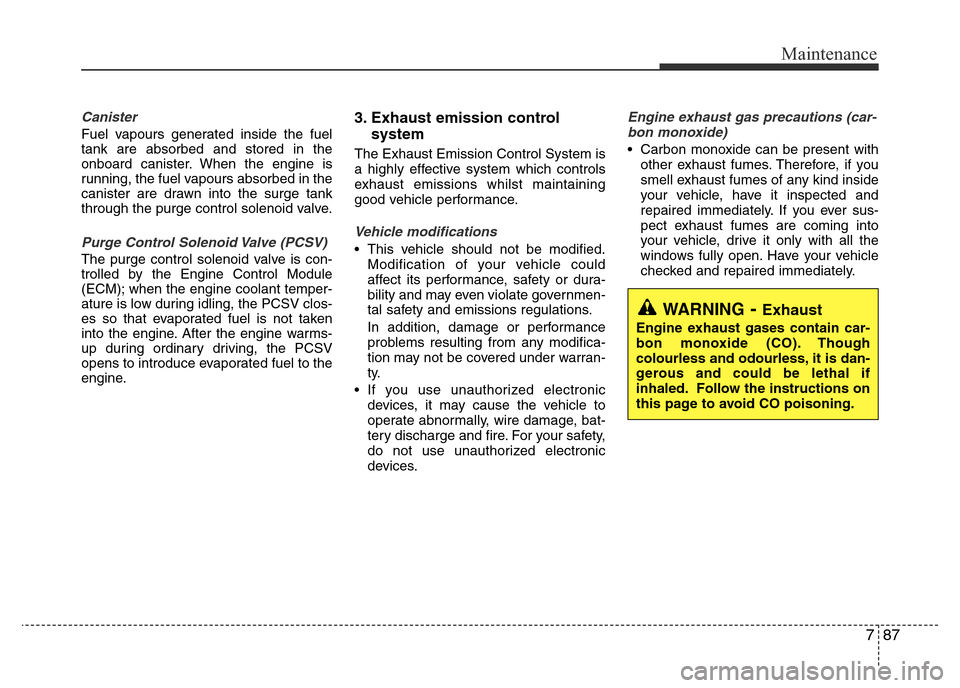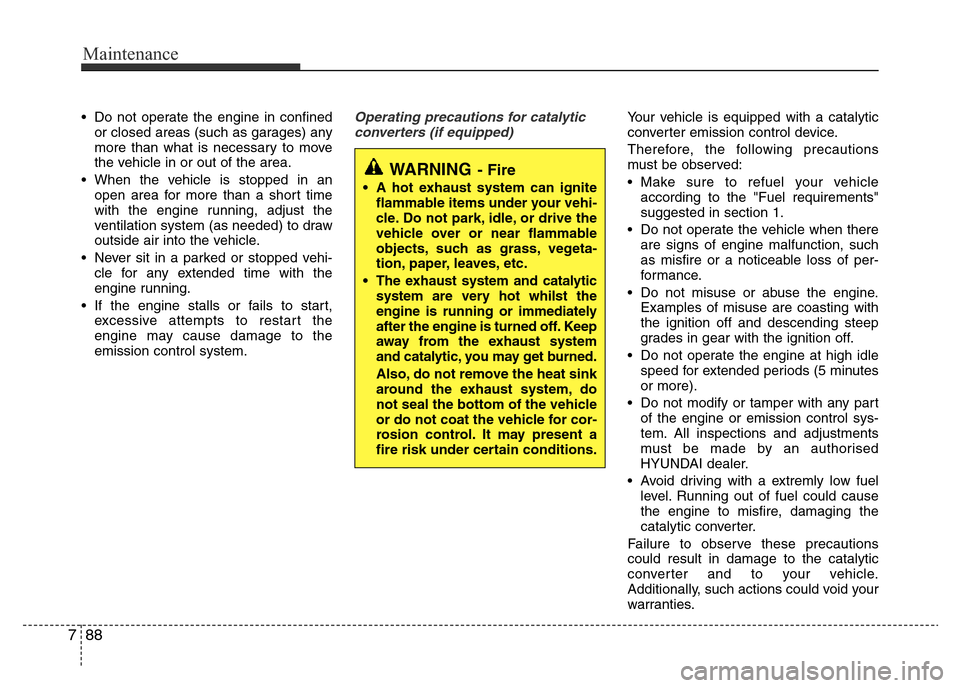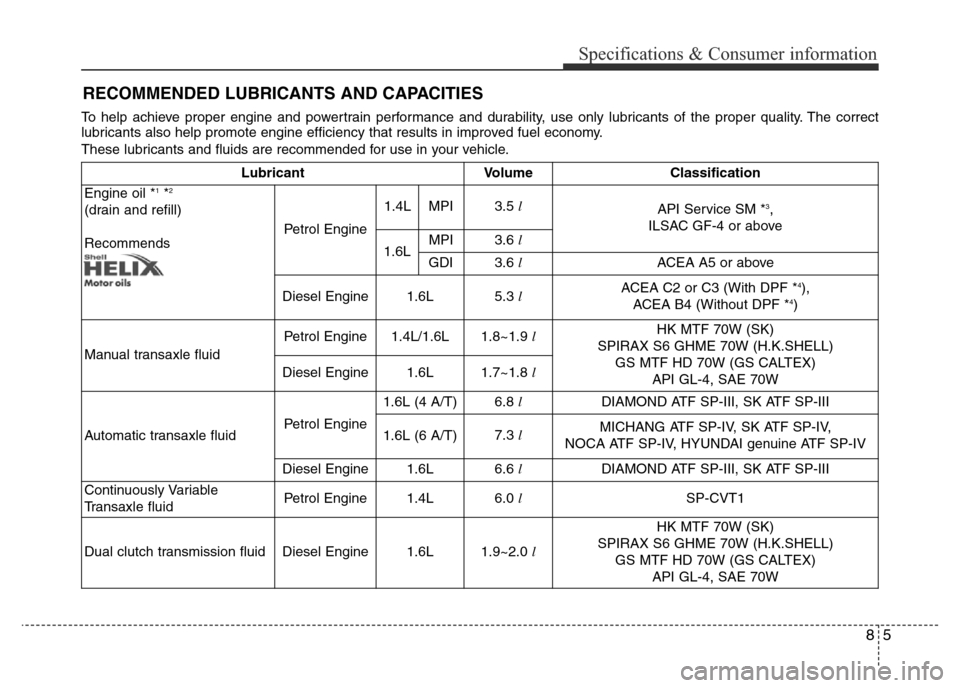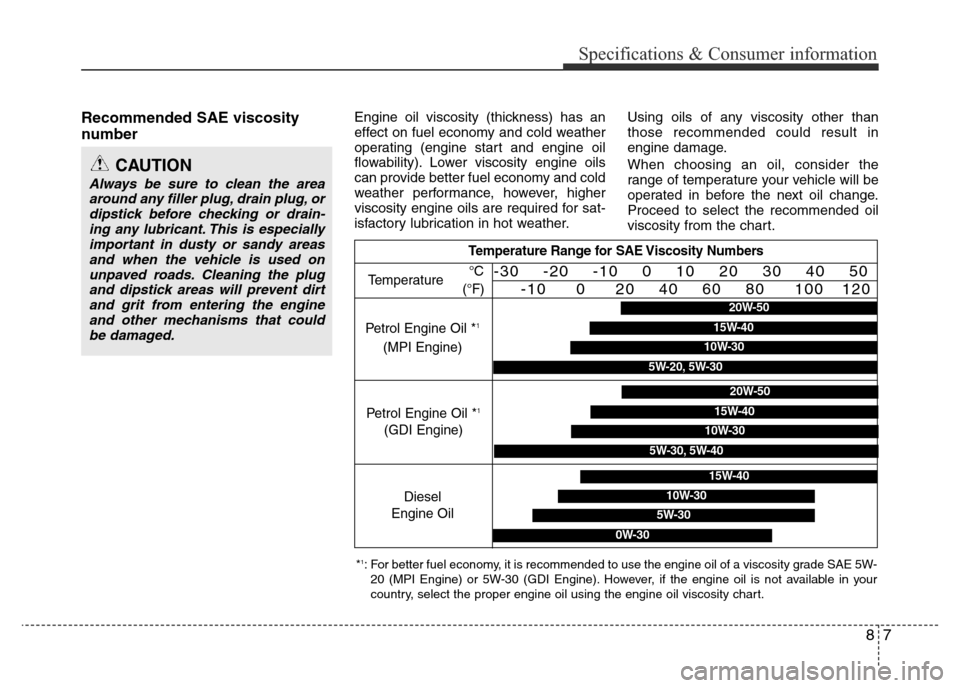Page 415 of 425

787
Maintenance
Canister
Fuel vapours generated inside the fuel
tank are absorbed and stored in the
onboard canister. When the engine is
running, the fuel vapours absorbed in the
canister are drawn into the surge tank
through the purge control solenoid valve.
Purge Control Solenoid Valve (PCSV)
The purge control solenoid valve is con-
trolled by the Engine Control Module
(ECM); when the engine coolant temper-
ature is low during idling, the PCSV clos-
es so that evaporated fuel is not taken
into the engine. After the engine warms-
up during ordinary driving, the PCSV
opens to introduce evaporated fuel to the
engine.
3. Exhaust emission control
system
The Exhaust Emission Control System is
a highly effective system which controls
exhaust emissions whilst maintaining
good vehicle performance.
Vehicle modifications
• This vehicle should not be modified.
Modification of your vehicle could
affect its performance, safety or dura-
bility and may even violate governmen-
tal safety and emissions regulations.
In addition, damage or performance
problems resulting from any modifica-
tion may not be covered under warran-
ty.
• If you use unauthorized electronic
devices, it may cause the vehicle to
operate abnormally, wire damage, bat-
tery discharge and fire. For your safety,
do not use unauthorized electronic
devices.
Engine exhaust gas precautions (car-
bon monoxide)
• Carbon monoxide can be present with
other exhaust fumes. Therefore, if you
smell exhaust fumes of any kind inside
your vehicle, have it inspected and
repaired immediately. If you ever sus-
pect exhaust fumes are coming into
your vehicle, drive it only with all the
windows fully open. Have your vehicle
checked and repaired immediately.
WARNING- Exhaust
Engine exhaust gases contain car-
bon monoxide (CO). Though
colourless and odourless, it is dan-
gerous and could be lethal if
inhaled. Follow the instructions on
this page to avoid CO poisoning.
Page 416 of 425

Maintenance
88 7
• Do not operate the engine in confined
or closed areas (such as garages) any
more than what is necessary to move
the vehicle in or out of the area.
• When the vehicle is stopped in an
open area for more than a short time
with the engine running, adjust the
ventilation system (as needed) to draw
outside air into the vehicle.
• Never sit in a parked or stopped vehi-
cle for any extended time with the
engine running.
• If the engine stalls or fails to start,
excessive attempts to restart the
engine may cause damage to the
emission control system.Operating precautions for catalytic
converters (if equipped)Your vehicle is equipped with a catalytic
converter emission control device.
Therefore, the following precautions
must be observed:
• Make sure to refuel your vehicle
according to the "Fuel requirements"
suggested in section 1.
• Do not operate the vehicle when there
are signs of engine malfunction, such
as misfire or a noticeable loss of per-
formance.
• Do not misuse or abuse the engine.
Examples of misuse are coasting with
the ignition off and descending steep
grades in gear with the ignition off.
• Do not operate the engine at high idle
speed for extended periods (5 minutes
or more).
• Do not modify or tamper with any part
of the engine or emission control sys-
tem. All inspections and adjustments
must be made by an authorised
HYUNDAI dealer.
• Avoid driving with a extremly low fuel
level. Running out of fuel could cause
the engine to misfire, damaging the
catalytic converter.
Failure to observe these precautions
could result in damage to the catalytic
converter and to your vehicle.
Additionally, such actions could void your
warranties.
WARNING- Fire
• A hot exhaust system can ignite
flammable items under your vehi-
cle. Do not park, idle, or drive the
vehicle over or near flammable
objects, such as grass, vegeta-
tion, paper, leaves, etc.
• The exhaust system and catalytic
system are very hot whilst the
engine is running or immediately
after the engine is turned off. Keep
away from the exhaust system
and catalytic, you may get burned.
Also, do not remove the heat sink
around the exhaust system, do
not seal the bottom of the vehicle
or do not coat the vehicle for cor-
rosion control. It may present a
fire risk under certain conditions.
Page 417 of 425
8
Engine / 8-2
Dimensions / 8-2
Bulb wattage / 8-3
Tyres and wheels / 8-4
Load and speed capacity tyres / 8-4
Weight/Volume / 8-4
Recommended lubricants and capacities / 8-5
Vehicle identification number (VIN) / 8-8
Vehicle certification label / 8-8
Tyre specification and pressure label / 8-9
Engine number / 8-9
Specifications & Consumer information
Page 418 of 425
Specifications & Consumer information
2 8
ENGINE
Item 4 Door5 Door
Overall length 4370 (172)
4115 (162)
Overall width 1700 (66.9)
1700 (66.9)
Overall height 1450 (57.1)
1450 (57.1)
Front tread175/70 R14 1507 (59.3)
1507 (59.3)
195/50 R16 1489 (58.6)
1489 (58.6)
Rear tread175/70 R14 1511 (59.5)
1511 (59.5)
195/50 R16 1493 (58.8)
1493 (58.8)
Wheelbase 2570 (101.2)
2570 (101.2)
DIMENSIONS
mm (in) Item
Petrol Kappa 1.4L Petrol Gamma 1.6L Diesel 1.6L
Displacement
cc (cu. in)
1368 (83.48) 1591 (97.09) 1582 (96.54)
Bore x Stroke
mm (in.)
72x84 (2.83x3.31) 77x85.44 (3.03x3.36) 77.2x84.5 (3.04x3.33)
Firing order
1-3-4-2 1-3-4-2 1-3-4-2
No. of cylinders
4, In-line 4, In-line 4, In-line
Page 421 of 425

85
Specifications & Consumer information
RECOMMENDED LUBRICANTS AND CAPACITIES
Lubricant Volume Classification
Engine oil *
1*2
(drain and refill)
RecommendsPetrol Engine3.5 l
API Service SM *3,
ILSAC GF-4 or above
3.6 l
3.6 lACEA A5 or above
Diesel Engine1.6L5.3 lACEA C2 or C3 (With DPF *4),
ACEA B4 (Without DPF *4)
Manual transaxle fluid
Petrol Engine1.4L/1.6L1.8~1.9 lHK MTF 70W (SK)
SPIRAX S6 GHME 70W (H.K.SHELL)
GS MTF HD 70W (GS CALTEX)
API GL-4, SAE 70W
Diesel Engine1.6L1.7~1.8 l
Automatic transaxle fluidPetrol Engine1.6L (4 A/T)6.8 l
DIAMOND ATF SP-III, SK ATF SP-III
1.6L (6 A/T)7.3 lMICHANG ATF SP-IV, SK ATF SP-IV,
NOCA ATF SP-IV, HYUNDAI genuine ATF SP-IV
Diesel Engine1.6L6.6 lDIAMOND ATF SP-III, SK ATF SP-III
Continuously Variable
Transaxle fluidPetrol Engine1.4L6.0 lSP-CVT1
Dual clutch transmission fluidDiesel Engine1.6L1.9~2.0 l
HK MTF 70W (SK)
SPIRAX S6 GHME 70W (H.K.SHELL)
GS MTF HD 70W (GS CALTEX)
API GL-4, SAE 70W
To help achieve proper engine and powertrain performance and durability, use only lubricants of the proper quality. The correct
lubricants also help promote engine efficiency that results in improved fuel economy.
These lubricants and fluids are recommended for use in your vehicle.
MPI
MPI 1.4L
1.6LGDI
Page 422 of 425
Specifications & Consumer information
6 8
*1: Refer to the recommended SAE viscosity numbers on the next page.
*2: Engine oils labeled Energy Conserving Oil are now available. Along with other additional benefits, they contribute to fuel econ-
omy by reducing the amount of fuel necessary to overcome engine friction. Often, these improvements are difficult to measure
in everyday driving, but in a year’s time, they can offer significant cost and energy savings.
*
3: If the API service SM engine oil is not available in your country, you are able to use API service SL.
*4: Diesel Particulate FilterLubricant Volume Classification
Coolant Petrol Engine 1.4L/1.6L5.3 l
MIXTURE, Antifreeze with water
(Ethylene glycol base coolant for aluminum
radiator)
Diesel Engine1.6L6.3 l
Brake/Clutch fluid0.7~0.8 lFMVSS116 DOT-3 or DOT-4
Fuel43 lUnleaded Fuel
Page 423 of 425

87
Specifications & Consumer information
Recommended SAE viscosity
numberEngine oil viscosity (thickness) has an
effect on fuel economy and cold weather
operating (engine start and engine oil
flowability). Lower viscosity engine oils
can provide better fuel economy and cold
weather performance, however, higher
viscosity engine oils are required for sat-
isfactory lubrication in hot weather.Using oils of any viscosity other than
those recommended could result in
engine damage.
When choosing an oil, consider the
range of temperature your vehicle will be
operated in before the next oil change.
Proceed to select the recommended oil
viscosity from the chart.
CAUTION
Always be sure to clean the area
around any filler plug, drain plug, or
dipstick before checking or drain-
ing any lubricant. This is especially
important in dusty or sandy areas
and when the vehicle is used on
unpaved roads. Cleaning the plug
and dipstick areas will prevent dirt
and grit from entering the engine
and other mechanisms that could
be damaged.
Temperature Range for SAE Viscosity Numbers
Temperature°C
(°F)-30 -20 -10 0 10 20 30 40 50
-10 0 20 40 60 80 100 120
Diesel
Engine Oil
5W-30
15W-40
10W-30
0W-30
*1: For better fuel economy, it is recommended to use the engine oil of a viscosity grade SAE 5W-
20 (MPI Engine) or 5W-30 (GDI Engine). However, if the engine oil is not available in your
country, select the proper engine oil using the engine oil viscosity chart.
Petrol Engine Oil *1
(MPI Engine)
20W-50
10W-30
15W-40
5W-20, 5W-30
Petrol Engine Oil *1
(GDI Engine)
20W-50
10W-30
15W-40
5W-30, 5W-40
Page 425 of 425
89
Specifications & Consumer information
The tyres supplied on your new vehicle
are chosen to provide the best perform-
ance for normal driving.
The tyre label located on the driver's side
centre pillar gives the tyre pressures rec-
ommended for your car.
TYRE SPECIFICATION AND
PRESSURE LABELENGINE NUMBER
ORB072017R
■ Petrol Engine (Kappa 1.4L)
■ Petrol Engine (Gamma 1.6L GDI)
ORB083006/ORBC080004/ORB080005/ORB080004
The engine number is stamped on the engine block as shown in the drawing.
■ Petrol Engine (Gamma 1.6L MPI)
■ Diesel Engine